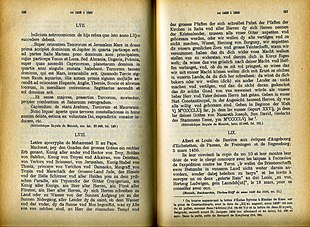
Back أبوكريفا Arabic Апокрыф Byelorussian Апокриф BXR Apocryffa Welsh Apócrifo (literatura) Spanish آپوکریفاها Persian Apocryphe (littérature et art) French Apacrafa Irish Ապոկրիֆ Armenian Apokrifa ID

Apocrypha are biblical or related writings not forming part of the accepted canon of Scripture. While some might be of doubtful authorship or authenticity,[1] in Christianity, the word apocryphal (ἀπόκρυφος) was first applied to writings which were to be read privately rather than in the public context of church services. Apocrypha were edifying Christian works that were not considered canonical scripture. It was not until well after the Protestant Reformation that the word apocrypha was used by some ecclesiastics to mean "false," "spurious," "bad," or "heretical."
From a Protestant point of view, biblical apocrypha are a set of texts included in the Septuagint (the Hebrew Bible in Greek), used for several hundred years by Jews and by early Christians, and still by Eastern Orthodoxy. In the centuries after the fall of Jerusalem, Jewish scholarship compiled the Masoretic Text in Hebrew, which remains the standard text used by Jews. Some books which were included in the Septuagint were not regarded as canonical, from the original Hebrew Bible, and were set apart and remained in Greek. Later, when Jerome translated the Canon of Scripture and produced the Latin Vulgate, he labelled those books as Apocrypha. Catholic and Orthodox Churches consider them to be deuterocanonical, whereas some Protestants consider them apocryphal, that is, non-canonical books that are useful for instruction.[2][3] Luther's Bible placed them in a separate section in between the Old Testament and New Testament called the Apocrypha, a convention followed by subsequent Protestant Bibles.[4] Some non-canonical apocryphal texts are called pseudepigrapha, a term that means "false attribution".[5]
The adjective "apocryphal", meaning of doubtful authenticity, mythical, fictional, is recorded from the late 16th century.[6]
- ^ "Apocrypha". Oxford English Dictionary (Online ed.). Oxford University Press. (Subscription or participating institution membership required.)
- ^ Wells, Preston B. (1911). The Story of the English Bible. Pentecostal Publishing Company. p. 41.
Fourteen books and parts of books are considered Apocryphal by Protestants. Three of these are recognized by Roman Catholics also as Apocryphal.
- ^ Cite error: The named reference
FUP1970was invoked but never defined (see the help page). - ^ Ewert, David (11 May 2010). A General Introduction to the Bible: From Ancient Tablets to Modern Translations. Zondervan. p. 104. ISBN 9780310872436.
English Bibles were patterned after those of the Continental Reformers by having the Apocrypha set off from the rest of the OT. Coverdale (1535) called them "Apocrypha". All English Bibles prior to 1629 contained the Apocrypha. Matthew's Bible (1537), the Great Bible (1539), the Geneva Bible (1560), the Bishop's Bible (1568), and the King James Bible (1611) contained the Apocrypha. Soon after the publication of the KJV, however, the English Bibles began to drop the Apocrypha and eventually they disappeared entirely. The first English Bible to be printed in America (1782–83) lacked the Apocrypha. In 1826 the British and Foreign Bible Society decided to no longer print them. Today the trend is in the opposite direction, and English Bibles with the Apocrypha are becoming more popular again.
- ^ Bromley, Geoffrey William, ed. (2009). "Apocrypha". The International Standard Bible Encyclopedia (2 ed.). Grand Rapids, Michigan: W.B. Eerdmans.
- ^ "apocryphal". Oxford English Dictionary (Online ed.). Oxford University Press. (Subscription or participating institution membership required.)
© MMXXIII Rich X Search. We shall prevail. All rights reserved. Rich X Search